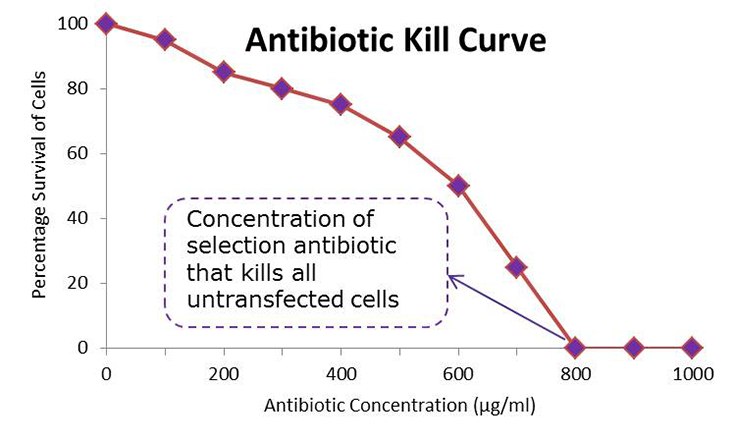Antibiotic Kill Curve
What is an antibiotic kill curve?
Antibiotic kill curve is a dose response experiment in which mammalian cells are subjected to increasing amounts of selection antibiotic to determine the minimum concentration of an antibiotic that can kill all the cells in a specific period of time. This is a crucial step before using a selection antibiotic to kill untransfected cells and generate stable cell lines. Since each mammalian cell line differs in antibiotic sensitivity, it is always recommended to perform separate kill curve experiments for different cell lines and antibiotics.
Recommended Concentrations of Antibiotics for a Kill Curve
The table below indicates the concentration ranges for commonly used selection antibiotics that may be adopted in dose response experiments.
The dose response may vary with the cell line being tested. The concentration ranges are only for guidance; a kill curve must be performed with every selection antibiotic when used for the first time or used on a new cell line.
Protocol for Kill Curve
The following protocol outlines the steps to generate kill curve for your cells.
What you need:
- Cell line of your interest in healthy condition
- Complete culture medium (medium + serum) recommended for your cell line
- Selection antibiotic of your interest
Steps:
- Harvest healthy adherent cells either by using trypsin or by gentle cell scraping.
- Dilute the cell suspension in complete medium and seed each well of 96-well plate so as that the final volume is 100 ul. The recommended cell density is ~50% on the day of treatment.
- Typical cell density before antibiotic treatment in a 24-well plate:
- 0.8 – 2.5 X 105 cells/ml of adherent cells
- 2.5 – 4.5 X 105 cells/ml of suspension cells
- Incubate at 37 oC overnight or till all the cells are well adjusted and healthy.
Note: Antibiotics are most effective when the cells are in active division; an optimum cell density is therefore recommended for most accurate dose response.

Figure 1.Schematic guide – selection antibiotic concentration.
- Replace the medium with fresh medium containing varying concentrations of selection antibiotic. Maintain each concentration in triplicates as indicated in the 96-well plate format (Figure 1).
- Replace the medium with antibiotic every 48 hours.
- Culture the cells for 7 – 10 days regularly observing the cells under light microscope. The duration of culture may be extended to 14 days depending on the cell line used.
- On day 10, determine the cell viability in each well either by MTT assay or by accurate cell counter.
- Choose a concentration of antibiotic that completely blocks the growth of cells. Use this concentration in all transfection experiments to select for resistant, transfected cells that can be further grown as stable cell lines (Figure 2).

Figure 2.Mock Antibiotic Kill Curve
Points to Remember
- Maintain appropriate controls or blanks:
- wells containing only medium with antibiotic, no cells
- wells containing medium and cells, no antibiotic
- Ensure the incubator is in perfect working condition to avoid evaporation of medium that might increase the concentration of antibiotic giving false readings
Select the right antibiotics for your cells.
Explore our entire antibiotics portfolio for your research use.
Click to explore our entire cell culture offering for your research use.
Materials
To continue reading please sign in or create an account.
Don't Have An Account?